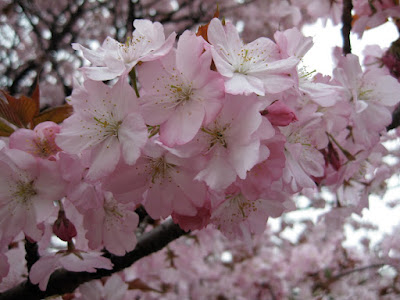Long before I came to Japan, I had already heard of the legendary cherry-blossoms (sakura). To me, Japanese sakura, were as integral to and iconic of Japan's traditional culture as the images of Geisha, Kabuki Theater, Sumo Games or the Tea Ceremony. However, only after having come to Japan and experiencing sakura for myself, did I discover this absolutely unique trait about them – something other elements of this beautiful culture do not have – and that is the recurring seasonal ardor. Japanese cherry-blossoms start out suddenly, bloom violently and passionately, and vanish just as abruptly as they came. And they do it every single year, annum after annum, eternally.
The intensity, almost vehemency of this however ephemeral life, juxtaposed against the graceful delicacy of flowers and the royalty to the season, has irreversibly captured my heart for good.
I wonder, when was the first time I ever drew a tree. I definitely cannot recall it. But I can bet, the first time I did it, the color I chose was green. Later, after I moved to Poland, my tree portraitures started to include red, brow, yellow or orange – all shades of warm colors that have been added into my color spectrum after my first autumn experiences. But it had never crossed my mind to ever color a tree pink. Leaves don't turn pink, I learned. Pink is for flowers.
 Now, how about a tree without leaves but full of flowers?
Now, how about a tree without leaves but full of flowers?If I had grown up in Japan, I would have been able to draw pink trees. Delightfully and stunningly pink trees. But these trees turn pink only once a year, for only as short as two weeks. They are like Japanese nature Cinderellas. In the winter, they are unsightly, dressed in gray branches, devoid of any color or attention. But in almost overnight, as if under a stroke of magic, they suddenly turn into the most splendid and charming things on earth capturing everyone's eye – from a busy office-worker on his hurried way to work,who just can't help but halt for a second to quickly snap a shot with his mobile phone, to professional photographers, pointing and shooting with their high-tech Japanese cameras for hours. Yes, sakuras are like Cinderella during the ball – everyone is watching them, everyone's in awe. And then, in a blink of eye, they're gone.

But that was all just my own imagination.
Historically actually, Japan has regarded sakura as a symbol of Samurai. “Sakura, these delicate flowers? Symbol of a belligerent warrior, who dies in violent battles? Where's the connection?” was my ignorant question, to which Ms. Kazuko Narui patiently answered: “It is because they are the symbol of loyalty and immutability. They come back every year, always at the same time. The Samurai, to whom nothing was more important than honor and loyalty, regarded the incessant return of sakura as symbolic of their own return to the Master whenever called upon. And the hope was, that they, the warriors, would also return from the war, just like sakura returns the next year, even if it fades away in less than 2 weeks. That was their prayer for survival. And that is why you see so many sakura in the temples and shrines.”

In my everyday life, I appear as a rather down-to-earth, occasionally sarcastic person, very much a realist and pragmatist.Then why, I wonder, is it that, just as soon as these pink flowers started blooming, my hopeless romanticism resurfaced and all I wanted was to sit or lay there and stare, endlessly, at these flowers against the blue sky, imagining all the stories I have recounted above. If there is a time most suitable for one to be a romantic, I think it is the sakura time.

In my everyday life, I appear as a rather down-to-earth, occasionally sarcastic person, very much a realist and pragmatist.Then why, I wonder, is it that, just as soon as these pink flowers started blooming, my hopeless romanticism resurfaced and all I wanted was to sit or lay there and stare, endlessly, at these flowers against the blue sky, imagining all the stories I have recounted above. If there is a time most suitable for one to be a romantic, I think it is the sakura time.


No comments:
Post a Comment